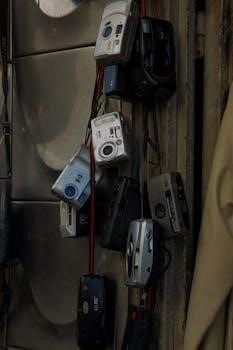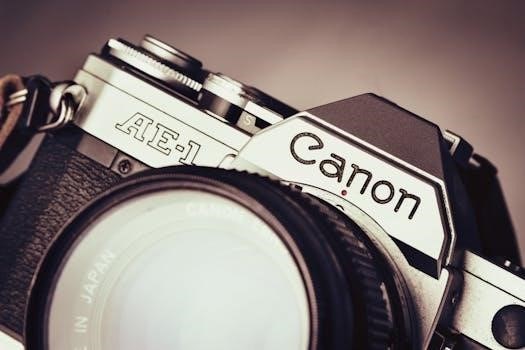Canon T50 Instruction Manual⁚ A Comprehensive Guide
Welcome to your comprehensive resource for the Canon T50 film SLR camera! This guide aims to provide you with all the necessary information‚ including the instruction manual‚ to maximize your camera’s potential and enjoy film photography․
The Canon T50‚ introduced in 1983‚ represents a significant step in making film photography accessible to a broader audience․ As an automatic-exposure‚ manual-focus SLR camera‚ the T50 prioritizes ease of use‚ perfect for those new to the world of interchangeable lens cameras․ Its design philosophy mirrors that of compact cameras‚ emphasizing simplicity in operation․ The T50 boasts a built-in power winder‚ enabling continuous shooting at 1․4 frames per second‚ a feature rarely found in cameras of its class at that time․ While it offers an advanced auto-exposure mode‚ it remains a manual focus camera‚ allowing users to engage with the fundamental aspects of photography․ Paired with Canon’s extensive range of FD lenses‚ the T50 provides a versatile platform for exploring various photographic styles․ Though some may find its automatic nature limiting‚ it serves as an excellent entry point into the Canon FD system․
Overview of Camera Features
The Canon T50 is equipped with several features designed to simplify the photographic process․ At its core is the programmed AE mode‚ which automatically sets both aperture and shutter speed‚ taking the guesswork out of exposure․ This mode is ideal for beginners seeking properly exposed images without manual adjustments․ A built-in power winder advances the film automatically‚ enabling continuous shooting at approximately 1․4 frames per second․ The camera utilizes Canon’s FD lens mount‚ granting access to a vast selection of interchangeable lenses․ Metering is handled internally‚ providing accurate light readings for the programmed AE mode․ The T50 requires two AA batteries to operate‚ powering the film advance‚ light meter‚ and electronic shutter․ A prominent selector dial allows users to switch between the “L” (lock)‚ and “P” (Program AE) settings․ The viewfinder displays essential information‚ including the “P” warning for low-light situations․ While lacking manual exposure controls‚ the T50 provides a user-friendly introduction to SLR photography․

Finding and Downloading the Manual
Accessing the Canon T50 instruction manual is easy! Several online resources provide free PDF downloads․ Explore reputable camera manual websites or online libraries to quickly locate and download your copy․
Free PDF Manual Downloads
Numerous websites offer the Canon T50 instruction manual as a free PDF download․ These resources aim to preserve and share vintage camera documentation‚ making it accessible to enthusiasts worldwide․ Popular sites include those dedicated to camera manuals and online libraries․ Before downloading‚ ensure the site is reputable to avoid malware․
Once downloaded‚ the PDF manual can be viewed on various devices‚ allowing for easy access in the field or at home․ These digital manuals often include searchable text‚ making it simple to find specific instructions or troubleshooting tips․ Consider saving the manual to multiple devices for backup․
By taking advantage of these free PDF downloads‚ you can unlock the full potential of your Canon T50 and enjoy a seamless film photography experience․
Where to Find Online Manuals
Locating online manuals for the Canon T50 is straightforward‚ thanks to numerous dedicated resources․ Websites specializing in camera manuals often host PDF versions available for free download․ These sites frequently maintain extensive libraries of vintage camera documentation‚ including service manuals and user guides․
Additionally‚ online photography communities and forums may offer links to scanned or transcribed manuals․ Manufacturer’s websites‚ while primarily focused on newer models‚ sometimes archive older manuals for legacy products․ Search engines can be valuable tools; use specific keywords like “Canon T50 manual PDF” to refine your search․
Always verify the source’s credibility before downloading any files․ Look for reputable websites with positive user reviews to ensure the manual’s accuracy and safety․ Remember to save the downloaded manual in multiple locations for easy access․

Understanding Basic Operations
Mastering the Canon T50 begins with understanding its basic operations․ This includes loading batteries‚ properly loading film‚ and setting the lens for programmed auto-exposure mode to start capturing memories effectively․
Loading Batteries
The Canon T50 requires two AA-size batteries to operate correctly․ Ensure you use fresh batteries of the same brand and type‚ preferably alkaline-manganese (LR6) batteries‚ for optimal performance․ To load the batteries‚ locate the battery compartment on the camera’s base․
Open the compartment cover by sliding it in the direction indicated by the arrow․ Insert the batteries according to the polarity markings (+ and -) inside the compartment․ Incorrect battery placement can damage the camera․
Once the batteries are correctly inserted‚ close the compartment cover until it clicks into place․ After loading‚ check the battery level indicator in the viewfinder to confirm sufficient power․ Replace the batteries if the indicator shows a low battery warning to avoid interruptions during shooting․ Regularly inspect the battery compartment for corrosion and clean it as needed to maintain good contact․
Film Loading Instructions
Loading film into the Canon T50 is a straightforward process․ First‚ open the camera back by gently pulling up the film rewind knob on the left side of the camera․ Next‚ insert the film cartridge into the film chamber‚ ensuring it sits securely․
Pull the film leader across the camera body and insert it into one of the take-up spool slots․ Advance the film using the film advance lever until the film sprockets engage with the sprocket holes on the film․
Close the camera back‚ making sure it clicks shut․ Continue advancing the film lever two or three times until the frame counter shows ‘1’․ The camera automatically handles film loading‚ eliminating manual winding․ Now you’re ready to start shooting! Remember to check the ISO setting is correct for the loaded film․
Setting the Lens for Programmed AE
To utilize the Canon T50’s Programmed AE (Automatic Exposure) mode‚ proper lens setup is crucial․ Begin by mounting an FD lens onto the camera body‚ ensuring it clicks securely into place․ Locate the aperture ring on the lens barrel‚ marked with various f-stop numbers․
To enable Programmed AE‚ rotate the aperture ring until it aligns with the green “A” setting․ This setting allows the camera to automatically select both the aperture and shutter speed for optimal exposure․ Once the lens is set to “A‚” the camera will manage the exposure settings based on the available light․
Confirm that the selector dial on the camera body is set to the “Program” mode for fully automated shooting․ With the lens and camera properly configured‚ you’re ready to capture well-exposed images effortlessly․

Troubleshooting Common Issues
Encountering problems with your Canon T50? This section addresses frequently asked questions and solutions for common issues‚ such as the flashing “P” warning and battery-related concerns‚ ensuring smooth operation․
Addressing the Flashing “P” Warning
The flashing “P” on your Canon T50 indicates insufficient light for proper exposure in Programmed AE mode․ This warning appears to prevent underexposed images․ However‚ if the “P” flashes even in seemingly well-lit conditions‚ several factors could be at play․
First‚ ensure the lens is correctly set to the ‘A’ (Automatic) position․ If the aperture ring is not properly aligned‚ the camera may struggle to determine the correct exposure․ Second‚ check your batteries․ Weak batteries can cause erratic meter readings‚ triggering the warning prematurely․ Replace them with fresh alkaline batteries of the same brand․
If the issue persists‚ the light meter itself may be faulty․ While not easily fixable without professional servicing‚ understanding these potential causes can help you diagnose the problem or explore alternative shooting options if available․
Battery Related Problems
The Canon T50 relies heavily on battery power for its operations‚ so battery issues can manifest in various ways․ Common problems include the camera not powering on‚ the film advance failing‚ or inaccurate light meter readings․ Always use two fresh AA batteries of the same brand and type (alkaline-manganese LR6 recommended) for optimal performance․
If the camera appears dead‚ double-check the battery installation polarity․ Ensure the batteries are correctly oriented according to the markings in the battery compartment․ Corrosion can also impede battery contact; clean the terminals with a dry cloth if necessary․
Weak batteries can cause the flashing “P” warning to appear even in adequate light‚ signaling the need for replacement․ When storing the camera for extended periods‚ remove the batteries to prevent leakage and potential damage to the internal components․ Proper battery maintenance ensures reliable operation of your Canon T50․

Exploring Advanced Features
Dive deeper into your Canon T50! While primarily automatic‚ understanding lens compatibility and Programmed AE opens creative doors․ Discover advanced techniques to elevate your film photography with this classic SLR camera․
Using FD Lenses
The Canon T50’s versatility shines through its compatibility with Canon’s FD lens system․ This opens a world of possibilities‚ from wide-angle landscapes to telephoto portraits․ While the T50 primarily operates in Programmed AE mode‚ understanding how FD lenses interact with this mode is crucial․
Remember that some older FL series lenses‚ though mountable‚ may not fully support the T50’s AE capabilities․ Specifically‚ lenses or close-up systems lacking AE signal pins might require extra attention to exposure․ Experimentation is key to mastering the nuances of different FD lenses on your T50․
Explore the creative potential of lenses like the FD 28mm f/2․8 for everyday shooting or consider a telephoto lens for distant subjects․ The T50’s manual focus system allows for precise control‚ ensuring sharp images with your chosen FD lens․
Understanding Programmed AE Mode
The Canon T50 primarily operates in Programmed AE (Automatic Exposure) mode‚ simplifying the shooting process․ In this mode‚ the camera automatically selects both the aperture and shutter speed based on the available light‚ relieving you of the need to manually adjust these settings․
This makes the T50 an excellent choice for beginners and those who prefer a straightforward shooting experience․ To engage Programmed AE‚ simply turn the selector dial to the “Program” setting․ The camera’s internal light meter will then determine the optimal exposure settings for the scene․
While Programmed AE simplifies shooting‚ understanding its limitations is essential․ The T50 does not offer manual exposure control or aperture-priority AE․ For more advanced control‚ consider exploring other cameras in the Canon FD system that offer these features․ However‚ for most everyday shooting situations‚ Programmed AE on the T50 provides excellent results․
Maintenance and Care
Proper maintenance is crucial for the longevity of your Canon T50․ Regular cleaning and appropriate storage will ensure optimal performance and prevent damage‚ allowing you to enjoy your camera for years․
General Cleaning Tips
Maintaining the cleanliness of your Canon T50 is essential for preserving its functionality and image quality․ Start by gently removing any loose dust or debris from the camera body using a soft brush or a blower․ For the lens‚ use a specialized lens cleaning cloth and solution‚ applying it in a circular motion to avoid scratches․
Avoid using harsh chemicals or abrasive materials‚ as they can damage the camera’s finish or internal components․ Pay particular attention to the viewfinder and film compartment‚ ensuring they are free from dust and contaminants․ Clean the battery contacts with a dry cloth to ensure proper electrical connection․
Regular cleaning will help prevent the build-up of dirt and grime‚ keeping your Canon T50 in excellent working condition for years to come․
Storage Recommendations
Proper storage is crucial for prolonging the life of your Canon T50․ When not in use‚ store the camera in a cool‚ dry place away from direct sunlight and extreme temperatures․ High humidity can lead to fungus growth on the lens and corrosion of internal components‚ so consider using a dehumidifying agent in your storage area․
Remove the batteries to prevent potential leakage‚ which can damage the camera’s electronics․ Store the camera in a protective case or bag to shield it from dust‚ scratches‚ and impact․ If storing for an extended period‚ consider wrapping the camera in acid-free tissue paper for added protection․
Ensure the lens is clean and dry before storage‚ and use a lens cap to prevent dust from entering․ Following these storage recommendations will help keep your Canon T50 in optimal condition for future use․


